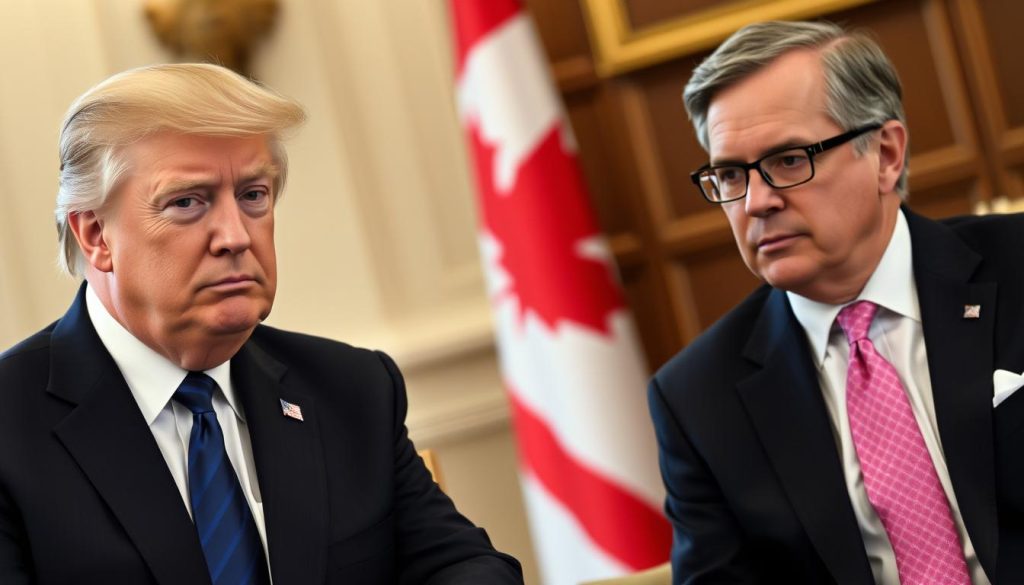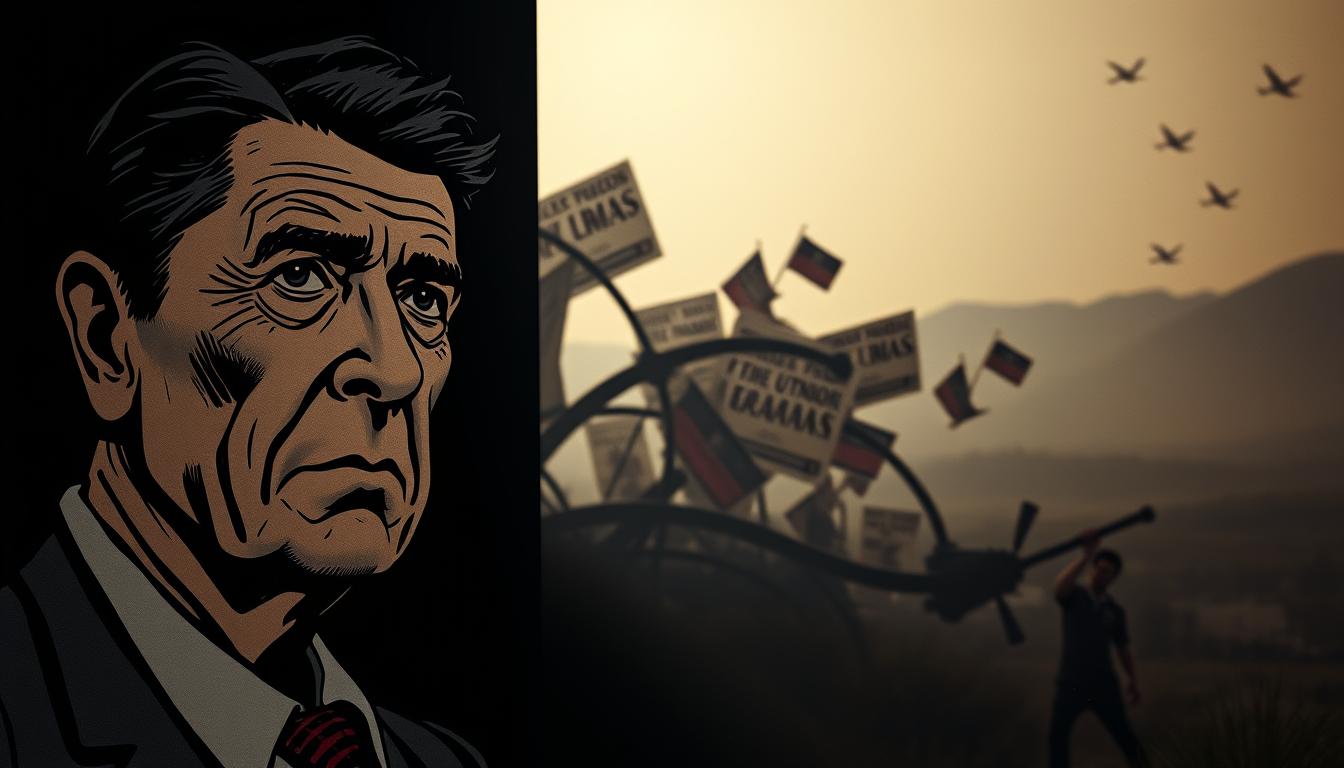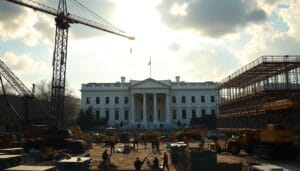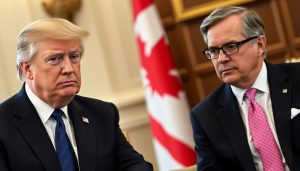Trade Talks with Canada Sour After Trump Video Mockery
Explore the latest on how Trade Talks with Canada Sour After Trump Video Mockery escalates tensions and impacts international relations.

Trade Talks with Canada
Late Thursday, President Trump said he was stopping all trade talks with Canada. This was after Ontario used a Ronald Reagan video in an ad. He wrote on social media that “tariffs ARE VERY IMPORTANT” for the U.S. economy and security.
He also said, “Based on their egregious behavior, ALL TRADE NEGOTIATIONS WITH CANADA ARE HEREBY TERMINATED.” This move worsened diplomatic tensions.
Ontario’s campaign, led by Premier Doug Ford, used Reagan’s words about protectionism. They bought ad space in major U.S. markets to argue against new duties. This came after months of tension and rising costs for consumers and businesses.
President Trump called the ad “fake” and said it was trying to influence a Supreme Court case on tariffs. People in Ottawa and trade experts quickly disagreed. They pointed out that nearly $3.6 billion in goods and services move across the border daily. Over three-quarters of Canadian exports go to the U.S. For more on this, see this reporting.
In Canada, officials said an open conflict could hurt auto plants, farms, and the logistics sector. Analysts noted new U.S. tariffs on Canadian cars and Canada’s retaliation. For a quick update on the tariff standoff, check this tariff update.
Now, the mood is clear: hard lines, high stakes, and few ways out. Whether talks can resume will shape North American trade and politics.
Trade Talks with CanadaKey Takeaways
- President Trump ended trade negotiations with Canada after an Ontario ad quoted Ronald Reagan on tariffs.
- Diplomatic tensions rose as the White House called the ad “fake” and linked it to a Supreme Court fight over tariffs.
- Ontario’s U.S.-facing campaign aimed to challenge tariffs by appealing to Reagan’s free-trade legacy.
- Daily cross-border commerce is vast, heightening the stakes for businesses and workers on both sides.
- Recent tariff moves and retaliation threaten supply chains and risk deeper economic fallout.
- Trade Talks with Canada Sour After Trump Video Mockery Highlights a New Low in Canada-U.S. Relations.
What Triggered the Breakdown in Canada-U.S. Trade Negotiations
Trade disputes and politics mixed in a big way, raising tensions. This led to a halt in talks, market worries, and a shift in how people view tariffs. The situation was made worse by a video from President Trump that mocked Canada.
Trump’s late-night announcement ended all trade talks with Canada
President Trump ended talks with Canada just before midnight. He called Ontario’s actions “egregious.” He said it was for national security reasons, citing tariffs and enforcement.
Ontario’s Reagan-themed ad buy and why it struck a nerve
Ontario spent $53.5 million on ads in the U.S. using Ronald Reagan’s words. The ads were during a Toronto Blue Jays game and were set for the World Series. They challenged tariffs on Canadian goods and opposed the “America First” policy.
The ad came at a time when U.S. tariffs were rising. This made the message even more impactful in Washington.
Claims of a “fake” ad and alleged interference with the U.S. Supreme Court
President Trump called the ad “fake” and said it was trying to influence the Supreme Court. He said Reagan supported tariffs, citing a statement from the Reagan Foundation. Critics argued Reagan warned about the dangers of tariffs, even with some exceptions.
Rapid response: Ontario pauses the ad to reopen talks
Premier Doug Ford said Ontario would stop the ad to restart talks. The goal was to reach U.S. audiences quickly and then calm things down. The situation was already tense, with threatened tariffs and boycotts.
Trade Talks with Canada Sour After Trump Video Mockery
Canada’s trade talks with the U.S. got worse. Business groups are worried about supply problems. Border states are seeing higher prices for fuel and food.
Escalating tariffs and targeted duties on Canadian industries
Starting in January, the U.S. imposed 25% duties on Canadian goods. Later, the rate went up to almost 35% for many exports. Steel, aluminum, and auto parts got hit hard, along with lumber.
Ottawa retaliated with tariffs on billions of U.S. products. Canada’s digital services tax, which starts on June 30, will add to the tension. U.S. firms might owe up to $3 billion, starting a cycle of response and countermeasure. A recent report shows the rising costs of energy, metals, and consumer goods.
Shifts in Canada’s trade relations: retaliation, boycotts, and political momentum
Provinces are removing U.S. brands from shelves. Grassroots boycotts are growing. Families are canceling trips to the U.S.
After Justin Trudeau stepped down, Prime Minister Mark Carney aims to diversify exports. Voters support expanding markets overseas. This suggests a long-term shift in Canada’s trade relations.
International trade agreements at risk amid diplomatic tensions
The review of the North American pact is delayed. This uncertainty affects suppliers who order months in advance. Companies are exploring alternative routes, and customs brokers are preparing for more checks.
If deadlines are missed, plans for automotive, energy, and agriculture could be rewritten. This strain on international trade agreements is a concern, even as talks are set to resume.
Political fallout in Washington and Ottawa from stalled trade negotiations
In Washington, there’s frustration over market access and industrial policy. The dispute is seen as overdue for enforcement. In Ottawa, Carney says talks were detailed and constructive, but Canada can’t dictate U.S. policy.
Union leaders, farm groups, and energy executives want clarity. With tensions high, lawmakers are testing new messages. Regional leaders are monitoring job data and border traffic amid trade disruptions.
Reagan’s Record, the Ad Controversy, and the Broader Policy Context
In Washington and Ottawa, the debate on tariffs has become real. People are now focusing on how past words affect today’s trade policies. This is important for international trade agreements that are under strain.

What Reagan actually said about tariffs and free trade
Ronald Reagan loved open markets but knew when to take special steps. He told that broad tariffs lead to retaliation and smaller markets. He also warned that protection can close factories and cut jobs.
Reagan balanced his support for free trade with careful actions when needed. His message linked prosperity to open supply lines and clear rules.
Reagan Foundation’s criticism versus the ad’s edited but consistent message
The Ronald Reagan Presidential Foundation & Institute criticized Ontario for selective clips and branding. Yet the ad’s line aligns with Reagan’s caution against broad barriers. The debate is more about context and consent than his stance.
The timing is critical as courts and policymakers look at tariffs. For more on the dates, quotes, and media buy, see this report on the Reagan ad controversy.
Economic ramifications: supply chains, jobs, and cross-border commerce
Tariff changes affect autos, steel, aluminum, and farm goods. These changes then hit stores and paychecks. Costs rise first, then consumer prices.
Analysts link tariffs to slower hiring and delayed investment. Manufacturers bear the cost. Household budgets suffer as retailers pass on higher costs. Walmart’s price increases and vendor pressures show how shocks affect stores, hinting at broader economic ramifications for families and small businesses tied to international trade agreements. For more on retail impacts, see this review of rising store prices and supply.
Strategic motives: leverage, trade disputes, and America First trade policies
The current approach uses tariffs and threats as leverage. Supporters see quick gains. Critics fear lasting trade disputes and damaged alliances that support international trade agreements.
Canada balances calm with resolve. Both sides watch markets while hardening positions. As new trade policies emerge, businesses weigh risk against opportunity in a changing landscape.
Trade Talks with Canada: Conclusion
Ontario’s Reagan-themed ad sparked a big issue when Donald Trump called it “fake” and linked it to a Supreme Court case. He ended the talks, and the trade talks with Canada became a big problem. Ontario stopped the ad after the World Series, and Prime Minister Mark Carney said Canada is ready for talks when Washington is.
This pause might open a door, but time is running out. The economic effects are significant, spanning steel and aluminum, energy, and autos. Investors are watching supply chains, and factories are thinking about hiring and shifts.
Even though cross-border flows are heavy, as shown in this report on Canada-U.S. trade stakes, policy changes can quickly affect freight, pricing, and jobs.
Politics is also a big part of this issue. The dispute raises old debates over free trade and today’s focus on tariffs. If leaders can separate the ad issue from tariffs, Canada’s trade relations might improve. But if not, retaliation, boycotts, and uncertainty will grow, affecting the whole continent.
The way forward is clear and simple: focus on sector terms, calm the rhetoric, and set a clear timeline. This is how the trade talks can move forward, creating workable rules on duties and quotas. Without this, the economic effects will last long, affecting more firms and workers in Canada’s trade relations.







